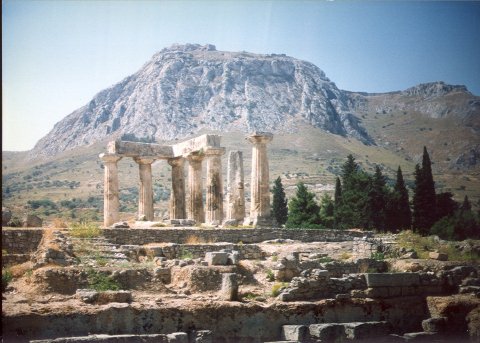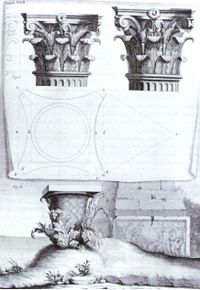

Corinthian
(in picture is Fr. Tomas)
The Corinthian
order is one of the Classical orders of Greek and Roman architecture,
characterized by a slender fluted column and an ornate capital decorated with
acanthus leaves and scrolls.
Although of
Greek origin, the Corinthian order was seldom used in Greek architecture. The other two orders were the Doric and the Ionic.
(When classical architecture was revived, two more orders were added to the
canon, the Tuscan order and the Composite order.)
used in Greek architecture. The other two orders were the Doric and the Ionic.
(When classical architecture was revived, two more orders were added to the
canon, the Tuscan order and the Composite order.)
![]() The
origin of the Corinthian order, illustrated in Claude Perrault's Vitruvius,
1684
The
origin of the Corinthian order, illustrated in Claude Perrault's Vitruvius,
1684
The
Corinthian order was said to have been invented by an architect, Callimachus,
who was inspired by the sight of a votive basket that had been left on the grave
of a young girl. A few of her toys were in it, and a square tile had been placed
over the basket, to protect them from the weather. An acanthus plant had grown
through the woven basket, mixing its spiny, deeply cut leaves with the weave of
the basket. Or so Vitruvius said. Claude Perrault incorporated a vignette
epitomizing the tale in his illustration of the Corinthian order for his
translation of Vitruvius, published in Paris, 1684 (illustration, left).
Perrault demonstrates in his engraving how the proportions of the carved capital
could be adjusted according to demands of the design, without offending. The
texture and outline of Perrault's leaves is dry and tight compared to their
19th-century naturalism at the U.S. Capitol (below, left).
![]() Greco-Bactrian
Corinthian capital, found at Ai-Khanoum, northeastern Afghanistan, 2nd century
BCE.
Greco-Bactrian
Corinthian capital, found at Ai-Khanoum, northeastern Afghanistan, 2nd century
BCE.
A Corinthian
capital may be seen as an enriched development of the Ionic capital, though one
may ha ve
to look closely at a Corinthian capital (illustration, right) to see the
Ionic volutes at the corners, perhaps reduced in size and importance, scrolling
out above the two ranks of stylized acanthus leaves, and to notice that smaller
volutes scroll inwards to meet each other on each side. The leaves may be quite
stiff, schematic and dry, or they may be extravagantly drilled and undercut,
naturalistic and spiky. In Late Antique and Byzantine practice, the leaves may
be blown sideways, as if by the wind of Faith. Unlike the Doric and Ionic column
capitals, a Corinthian capital has no neck beneath it, just a ring-like astragal
molding or a banding that forms the base of the capital, recalling the base of
the legendary basket.
ve
to look closely at a Corinthian capital (illustration, right) to see the
Ionic volutes at the corners, perhaps reduced in size and importance, scrolling
out above the two ranks of stylized acanthus leaves, and to notice that smaller
volutes scroll inwards to meet each other on each side. The leaves may be quite
stiff, schematic and dry, or they may be extravagantly drilled and undercut,
naturalistic and spiky. In Late Antique and Byzantine practice, the leaves may
be blown sideways, as if by the wind of Faith. Unlike the Doric and Ionic column
capitals, a Corinthian capital has no neck beneath it, just a ring-like astragal
molding or a banding that forms the base of the capital, recalling the base of
the legendary basket.
The Corinthian column is almost always fluted. If it is not, it is often worth pausing to unravel the reason why (sometimes simply a tight budget). Even the flutes of a Corinthian column may be enriched. They may be filleted, with rods nestled within the hollow flutes, or stop-fluted, with the rods rising a third of the way, to where the entices begins. The French like to call these chandelles and sometimes they end them literally with carved wisps of flame, or with bellflowers. Alternately, beading or chains of husks may take the place of the fillets in the fluting, for Corinthian is the most playful and flexible of the orders. Its atmosphere is rich and festive, with more opportunities for variation than the other orders.
Holy Land Greece Pilgrimages Pilgrimages Map Index Espaņol English Index